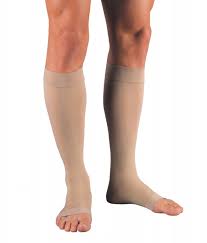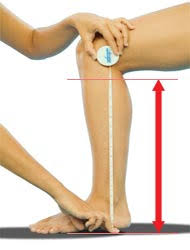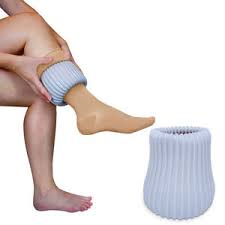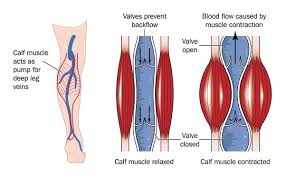Pressure (compression) Therapy
 Compression stockings are used for pressure or compression therapy. These stockings apply a mechanical force to increase external pressure on the feet, ankles, calves, or thighs. The amount of pressure is set at a pre-determined range, measured in millimeters of Mercury (mmHg) for each pair of stockings. This is a measurement of gradient pressure exerted over a gradually decreasing amount of pressure up the leg, which the wearer will feel. Pressure levels can be prescribed from 10-60mmHg, depending on the condition and therapeutic needs. Any pressure levels greater than 20mmHg requires a doctor’s referral or prescription. The standard of care for scar management is usually at 25 mmHg.
Compression stockings are used for pressure or compression therapy. These stockings apply a mechanical force to increase external pressure on the feet, ankles, calves, or thighs. The amount of pressure is set at a pre-determined range, measured in millimeters of Mercury (mmHg) for each pair of stockings. This is a measurement of gradient pressure exerted over a gradually decreasing amount of pressure up the leg, which the wearer will feel. Pressure levels can be prescribed from 10-60mmHg, depending on the condition and therapeutic needs. Any pressure levels greater than 20mmHg requires a doctor’s referral or prescription. The standard of care for scar management is usually at 25 mmHg.
Conditions Indicated for Compression Stockings
Compression stockings are intended to provide a therapeutic effect and may be used to improve fluid balance and circulation, or to manage or modify scar tissue formation. In addition, they may help with the following conditions:
- Venous insufficiency (reticular veins, varicose veins, vascular anomalies where the venous valves are not opening and closing properly
 to allow incoming and outgoing blood flow).
to allow incoming and outgoing blood flow). - Tired, swollen, or aching legs (from standing or sitting for long periods of time).
- Spider veins (smaller, red, purple, and blue vessels that twist and turn).
- Varicose veins (large, raised, swollen blood vessels that twist and turn).
- Venous ulcers (wounds that occur from improper functioning of venous valves).
- Deep Vein Thrombosis (a blood clotthat forms in a vein deep in the body, such as the leg or thigh and can result in pulmonary embolism if the clot breaks apart).
- Lymphedema (swelling due to lymphatic conditions where there is buildup of protein rich fluid due to congenital, post-infection, or post-radiation treatment issues).
- Acute edema (limb swelling after trauma or surgery).
- Other types of edema (caused by heart or kidney disease, medication side effects, pregnancy).
- For control of hypertrophic scarring (after burn injuries, surgical scars).
Styles of Compression Stockings
 Compression stockings come in a variety of sizes and lengths,
Compression stockings come in a variety of sizes and lengths,
 compression grades, colors,and fabrics (nylon, spandex, polyester, cotton, and silicone). For example, you can choose knee-high, thigh-high, or waist high;
compression grades, colors,and fabrics (nylon, spandex, polyester, cotton, and silicone). For example, you can choose knee-high, thigh-high, or waist high;
open or closed toe; 10-60 mmHg of compression; and all varieties of colors depending on the manufacturer.
 Regardless of whether you want to address venous, lymphatic, or diabetic conditions; swelling and discomfort from pregnancy; travel comfort while flying or sitting for long periods; prevention of disease; improving athletic or sport performance and comfort; or acute conditions during or after hospitalization; there are many styles available. You can choose from sheer, opaque, soft, casual, classic, sport, activewear, travel wear, ulcer care, and others.
Regardless of whether you want to address venous, lymphatic, or diabetic conditions; swelling and discomfort from pregnancy; travel comfort while flying or sitting for long periods; prevention of disease; improving athletic or sport performance and comfort; or acute conditions during or after hospitalization; there are many styles available. You can choose from sheer, opaque, soft, casual, classic, sport, activewear, travel wear, ulcer care, and others.
How to Select Compression Stocking
First, if you’re detecting circulation problems or have concerns about a condition you’re experiencing (numbness, pain or cramps, swelling, ulcers, loss of sensation, headaches, blue discoloration, varicose veins), it’s important you seek consultation with your doctor or a vascular/vein specialist (phlebologist). Venous disorders are quite common and can affect many people from all walks of life. Anyone can  walk into a pharmacy or medical equipment retailer to purchase non-prescription (less than 20 mmHg compression stockings), but you may need a prescription grade of compression, so consulting a doctor is a smart first step. Once you’ve done that, you can come to a medical or healthcare equipment retailer to consult with their staff (preferably one with a compression stocking fitter certification) to identify and select the appropriate compression stockings for you. You’ll need to be measured and fitted for the correct size.
walk into a pharmacy or medical equipment retailer to purchase non-prescription (less than 20 mmHg compression stockings), but you may need a prescription grade of compression, so consulting a doctor is a smart first step. Once you’ve done that, you can come to a medical or healthcare equipment retailer to consult with their staff (preferably one with a compression stocking fitter certification) to identify and select the appropriate compression stockings for you. You’ll need to be measured and fitted for the correct size.
This chart includes the compression grades and conditions they are prescribed for treating:



 Remember to avoid folding or rolling the top down so that they don’t interfere with blood circulation. Wear your stockings during the day when you are actively standing, walking, and intermittently sitting, rather than when laying down or sleeping. Take them off to shower or bathe. You can wear slippers or shoes with them. Check with your doctor to ensure you have the correct gradient pressure, style, and fit. Compression stockings can be put on and taken off using specialty gloves or doff and donner products.
Remember to avoid folding or rolling the top down so that they don’t interfere with blood circulation. Wear your stockings during the day when you are actively standing, walking, and intermittently sitting, rather than when laying down or sleeping. Take them off to shower or bathe. You can wear slippers or shoes with them. Check with your doctor to ensure you have the correct gradient pressure, style, and fit. Compression stockings can be put on and taken off using specialty gloves or doff and donner products. Avoid wearing tight clothing so it won’t interfere with blood flow.
Avoid wearing tight clothing so it won’t interfere with blood flow.
